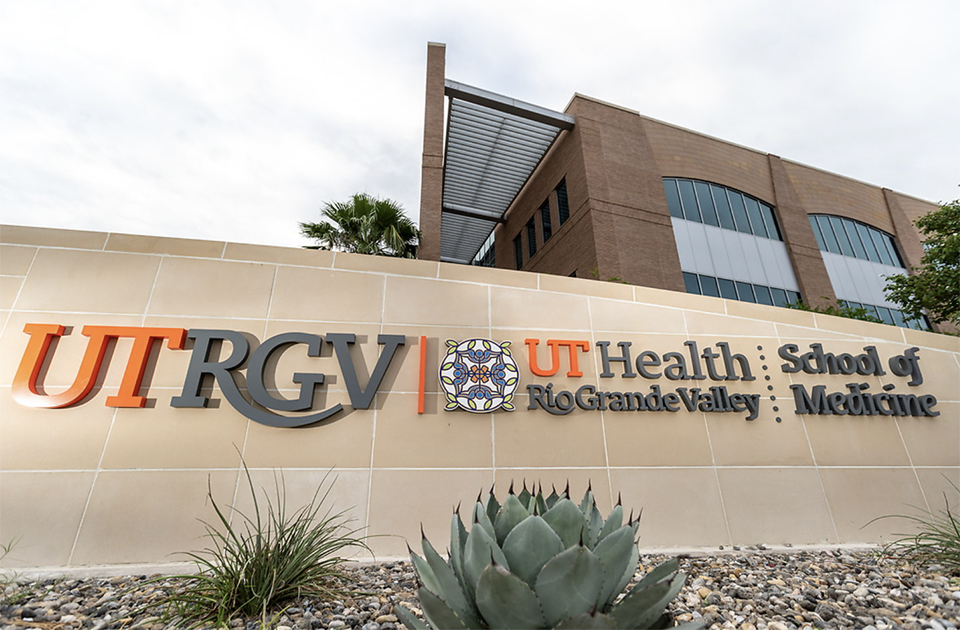
(UTRGV Photo by David Pike)
News Release | Research

(UTRGV Photo by David Pike)
Wednesday, November 29, 2023
Research, Grants
By News and Internal Communications
RIO GRANDE VALLEY, TEXAS – NOV. 29. 2023 – UTRGV recently was awarded $10.6M by the National Institutes of Health to support genetic research on depression and liver disease among Hispanics – a majority demographic in the Rio Grande Valley with high rates of both disorders.
The NIH’s National Human Genome Research Institute (NHGRI) awarded UTRGV’s South Texas Diabetes and Obesity Institute (STDOI) the grant as part of a new program to establish genomic research centers that will work as part of a consortium to diversify the genomics workforce.
In addition to UTRGV, the NHGRI’s new program establishes Diversity Centers for Genome Research at Meharry Medical College in Nashville, Tennessee, and at the University of Hawaii at Manoa – all minority-serving institutions.
Dr. Sarah Williams-Blangero, chief of the UTRGV School of Medicine’s Division of Human Genetics and principal investigator on the UTRGV Diversity Center for Genome Research grant, said the centers provide opportunities for minority students and faculty to get involved in genetic research.

“The National Human Genome Research Institute sees diversifying the genetics workforce as a critical component of ensuring that genetic research benefits all populations, including those that currently are underrepresented in biomedical research,” said Williams-Blangero, who will serve as the inaugural chair of the consortium program.
She said the federally funded research centers will increase capacity for genomic research by providing training opportunities for individuals at a range of educational and career levels, from high school students to senior researchers.
“The research projects conducted in our new center will be meaningful to trainees since the focal diseases disproportionately impact families in the Rio Grande Valley,” she said.
HISPANIC RESEARCH FOCUS
The UTRGV Diversity Center for Genome Research includes two major research projects on diseases that are health disparities for Mexican Americans: non-alcoholic fatty liver disease, and major depressive disorder.
The non-alcoholic fatty liver disease (NAFLD) project, led by STDOI scientists Dr. Joanne Curran and Dr. Satish Kumar, aims to better understand the root cause of NAFLD.
Similar to Curran’s $8 million NIH-funded study, the NAFLD project examines the interaction of genetic and environmental factors.
“This is a major public health issue affecting millions of people worldwide,” Williams-Blangero said. “The Hispanic population experiences the highest prevalence of NAFLD, so the research that Drs. Curran and Kumar are conducting is particularly important for the Rio Grande Valley.”
The research aims to suggest approaches for improved early detection of disease.
Dr. John Blangero is leading the center’s study on genetic factors and exposure to pollutants – which seemingly influences recurrent major depressive disorder (MDD) risk disproportionately among Mexican Americans.
Blangero will analyze data from the long-running Mexican American Family Study to better understand environment interactions influencing genetic susceptibility to recurrent MDD.
He will use a novel statistical approach he created to control for genetic effects in order to enhance the ability to detect the environmental influences on disease risk.
“We are excited by the potential impact of this program,” Williams-Blangero said. “The UTRGV Diversity Center for Genome Research includes not only cutting-edge research projects but also significant community outreach and workforce development efforts. The Center grant hekps bring UTRGV closer to its goal of becoming an Emerging Research University.”
UTRGV-WIDE COLLABORATION
The Diversity Center for Genome Research involves scientists and investigators from across UTRGV, including the South Texas Diabetes and Obesity Institute; UTRGV School of Medicine's Divisions of Human Genetics, Population Health and Biostatistics, and Neuro- and Behavioral Health; the College of Science; and the College of Education and P-16 Integration.
Dr. Michael B. Hocker, senior vice president for UT Health RGV and dean of the UTRGV School of Medicine, said the NIH award represents the caliber of collaborative research being conducted by UTRGV faculty.
“We’re entrusted with this federal funding to carry out important research goals,” he said. “While seeking solutions for our local community, we are working collaboratively to make valuable health discoveries that improve our community and our country’s well-being as a whole.”
ABOUT UTRGV
The University of Texas Rio Grande Valley (UTRGV) was created by the Texas Legislature in 2013 as the first major public university of the 21st century in Texas. This transformative initiative provided the opportunity to expand educational opportunities in the Rio Grande Valley, including a new School of Medicine and a School of Podiatry, and made it possible for residents of the region to benefit from the Permanent University Fund – a public endowment contributing support to the University of Texas System and other institutions.
UTRGV has campuses and off-campus research and teaching sites throughout the Rio Grande Valley including Brownsville (formerly The University of Texas at Brownsville campus), Edinburg (formerly The University of Texas-Pan American campus), Harlingen, Weslaco, McAllen, Port Isabel, Rio Grande City and South Padre Island. UTRGV, a comprehensive academic institution, enrolled its first class in the fall of 2015; the School of Medicine welcomed its first class in the summer of 2016, and the School of Podiatric Medicine in the fall of 2022.